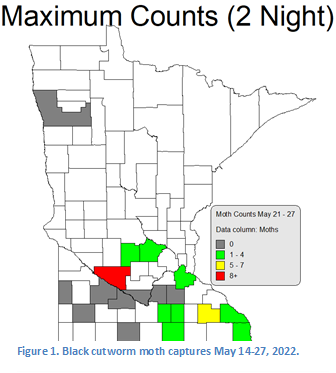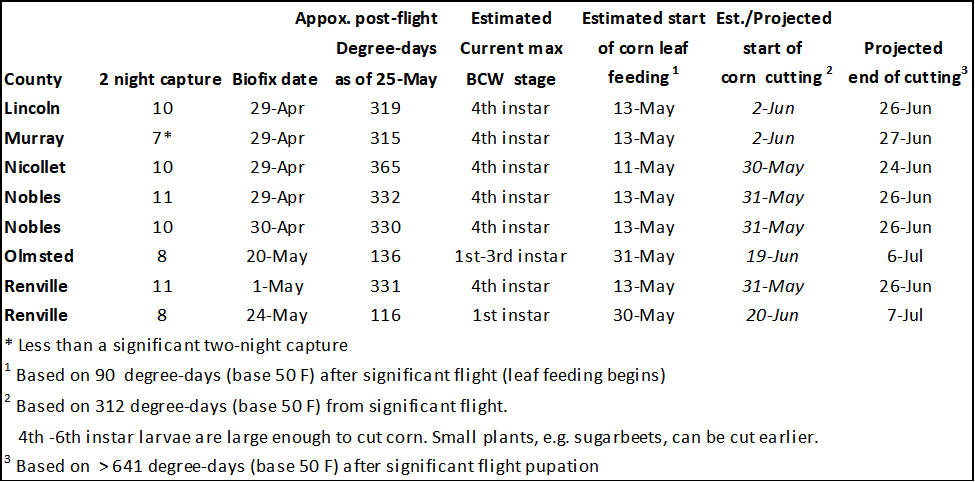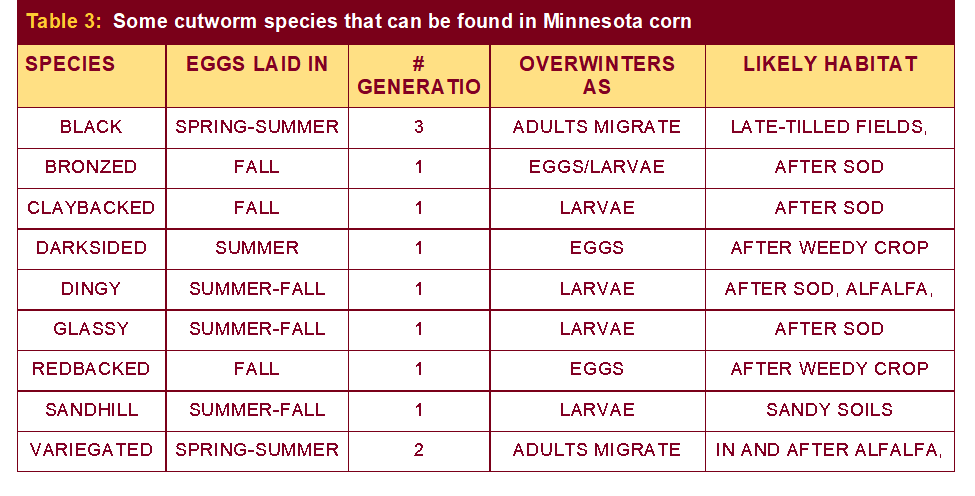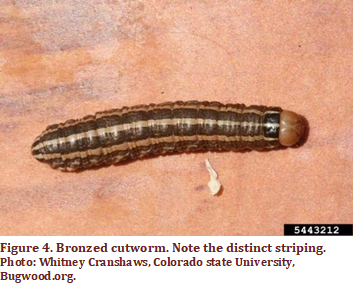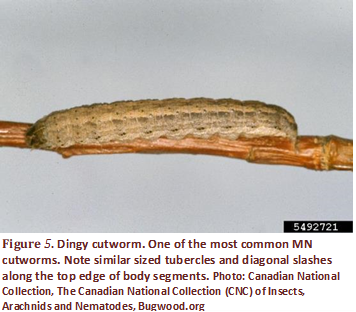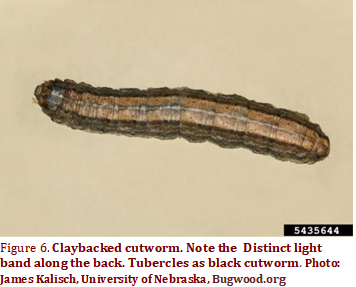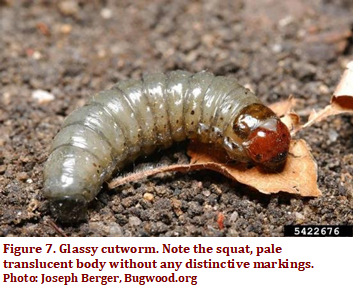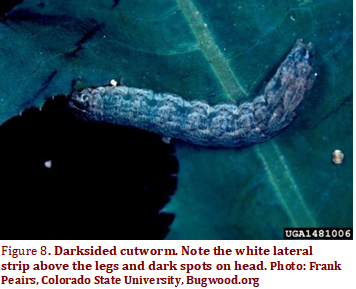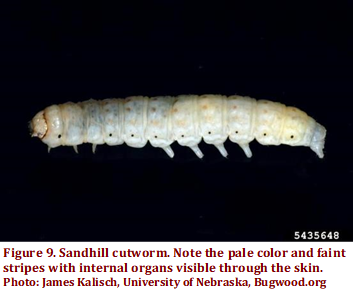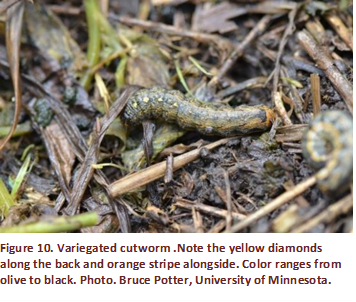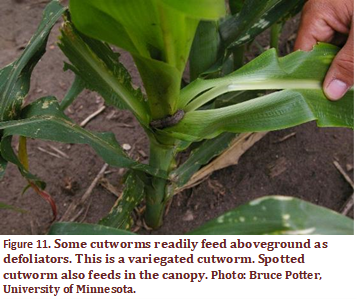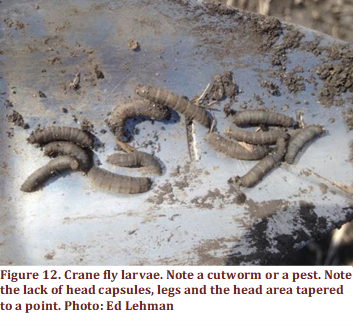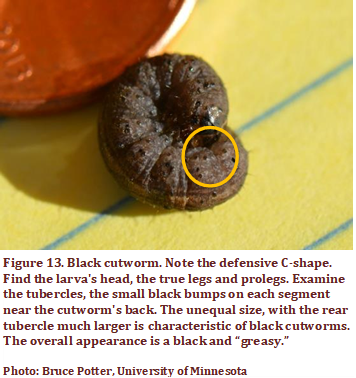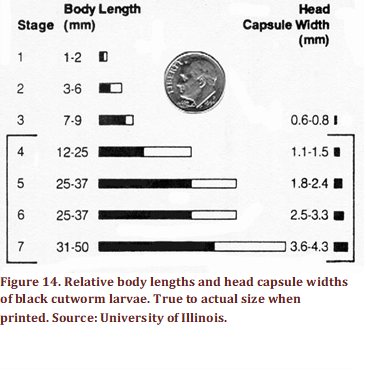2022 University of Minnesota Cooperative Black Cutworm Trapping Network
For more information: https://z.umn.edu/bcw-reporting
June 03, 2022
Greetings:
Some trappers have stopped for the season as planting wrapped up. Traps in the
southeast were still picking up moths. It was another week of relatively low captures. However, a Renville County trap detected a significant flight on May 24-25 (Figure 1, Table 1). This is the second significant flight in this county.
The greatest risk is still from the moths arriving April 29 to May 1. Some of the larvae from these flights should be large enough to cut now. The larvae from the most recent Olmsted and Renville County flights will be further behind in development (Table 2).
The delayed planting in some areas means there is a lot of small corn out there.
Table 1. Positive captures in pheromone traps reported April 30 - May 6, 2022. Numbers in parenthesis indicate multiple captures for that trap and date.
Table 2. Black cutworm development projections are based on historical average temperatures. Midwest Regional Climate Center U2U https://mygeohub.org/groups/u2u/purdue_gdd
I would appreciate hearing of cutworm problems this spring. I have received a few reports of cutworms this spring, none of which have been black cutworms.
There are several cutworm species that you might find in your crop fields. We discussed the difference between black and dingy cutworms in a previous issue. Black, glassy, sandhill, and redbacked cutworms are species most likely to cut plants below ground.
The following provides tips on the identification of black cutworms.
From Black Cutworm Facts Revised - April 2021
OTHER CUTWORM SPECIES IN MINNESOTA CORN
Black cutworms are not the only cutworm species than can injure crops in Minnesota. As corn (and other row crops) germinate and begin to emerge they can be attacked by several species of cutworms. Table 6 lists some of the species that might be found in Minnesota corn fields.
Most species can overwinter in Minnesota as eggs or larvae. Black and variegated cutworms cannot winter here and migrate into the state each spring.
While we can project cutting dates for the black cutworm, corn should be scouted for other cutworm species as soon as it emerges.
Because cutworms that overwinter, particularly those that winter as larvae, begin development before migrant black cutworms arrive, they are ready to feed on corn early. Often, the first corn leaf feeding observed in the spring is from overwintered dingy cutworm larvae. Dingy cutworms are commonly found in corn, but unlike black cutworms are seldom a threat. With a bit of practice, the two species are easily distinguished by the size of paired black bumps (tubercles) on the upper edges of each segment. These tubercles are unequal in size on the black cutworm. Other Minnesota insects that cause damage to larger corn and might be confused with cutworm include the hop vine borer and common stalk borer. Some of the insect larvae commonly observed in corn are shown in Figures 13-22.
Particular habitats are preferred by most cutworm species (Table 3). For example, sandhill cutworms are found in sandy soils and several species tend to be problems in crops planted into sod. Dingy cutworms are often abundant when corn is planted after alfalfa or fields that were weedy the previous year.
Species identification is important to determine damage potential. Small larvae of all species feed on weeds and leaves and cannot cut corn. In addition to dingy cutworms, Dingy, redbacked, spotted, and variegated cutworms are primarily leaf feeders feeding at or above the soil surface. Consequently, these climbing cutworms don’t usually cut corn below the soil line and growing point and the plant recovers. However, unlike the climbing cutworms, the larvae of some cutworm species (e.g., glassy, sandhill, darksided, claybacked and black) tend to feed below ground at or below the growing point. This potential for feeding to kill corn plants makes black cutworms a threat. When larger larvae tunnel into the growing point, corn as large as 5 or 6 leaves can be killed. Fortunately, damaging black cutworm populations are infrequently encountered.
What about other crops?
The growing points of broadleaf crops are above ground. Plants will be killed if cut below the cotyledons; even climbing cutworm species can be a threat. Since yield loss from cutworms is related to stand loss, crops that are less able to compensate for stand loss are at greater risk.
While black cutworm larvae will cut soybeans, they are less likely to create a yield-limiting problem in this crop. Soybeans are seeded at a much higher plant density and can compensate (up to a point) for reduced stand much better than corn.
Sugarbeets are at risk because of yield and quality sensitivity to beet stand. In addition, they are planted early and often with an oat cover which may encourage black cutworm egg-laying. Cutworms will move to beet seedlings as oats and weeds are killed by herbicides.
The last report for 2022 will be next week.
Until next week,
Bruce and Travis

